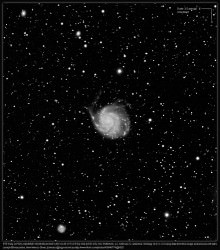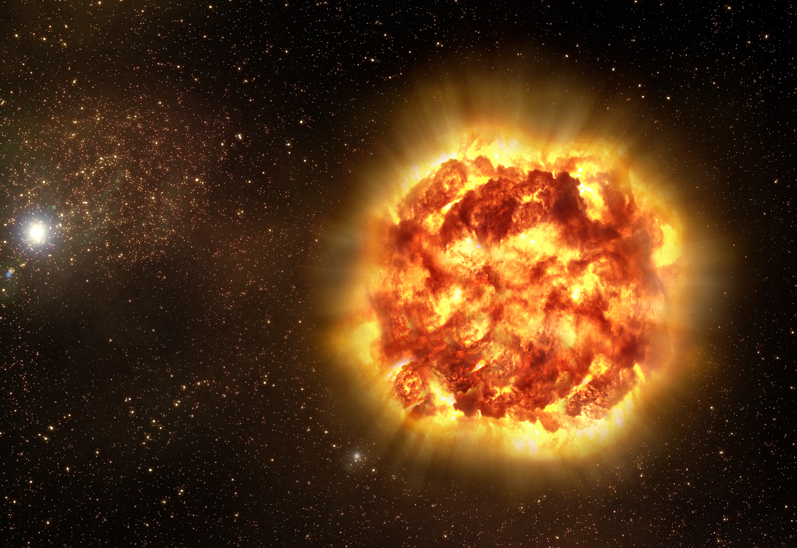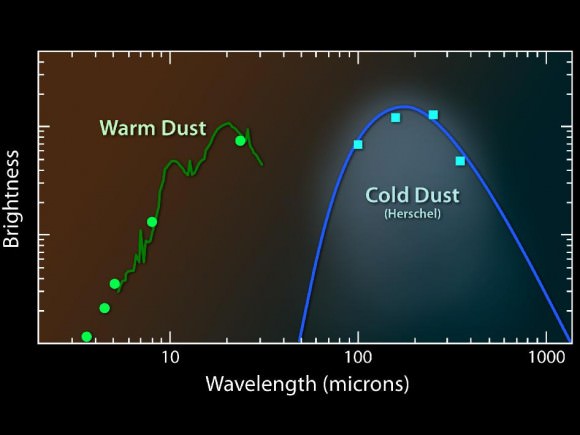[/caption]
Are you curious about what’s happening with the supernova event in Messier 101? What’s its magnitude and how can you observe it? Then step out here into the back yard with me and let’s discuss some facts.
First off, you’re not going to be able to see the Messier 101 supernova event with your unaided eye. The brightness of celestial objects are categorized by a number that denotes magnitude. A negative number, such as -4 is blazing – like Venus in all its glory. A small number, like 3 is about the average brightness of most of the stars you can see in the urban glow. Higher numbers, like 12, are so faint you’d need a large telescope to see them. And when it comes to just using your eyes, you’ll be lucky to spot a 6 when you’re well dark adapted and in a non-light polluted location.
And right now the brightest the supernova has been so far was two days ago at magnitude 10.
Next up? Right now there’s a light pollution source we simply can’t escape… the Moon. Given absolutely pristine skies and a very, very large telescope you might be able to cut through the normal thin atmospheric haze and catch the supernova. Are you going to see Messier 101? Very doubtful. But here’s where your computerized telescope comes into play. You’ll need to enter the coordinates: RA: 14:03:05.81 , Dec: +54:16:25.4. If you are perfectly polar aligned, this will place the supernova directly in the center of the field of view. Using a light pollution filter will only darken the event as well, so you are best off to use a higher magnification eyepiece to darken the field, but I personally wouldn’t recommend anything stronger than a 10mm unless you’ve got a long focal ratio scope. Now go to the eyepiece and match up star patterns. You’re not going to see the galaxy, but you will see the field stars.
Until the Moon leaves the sky, it’s improbable (but not impossible) that you’ll be able to see SN 2011fe with anything less than around a 12-16″ telescope. Even though your telescope may be rated as reaching a stellar magnitude 13, we simply can’t break the rules of physics. But don’t be discouraged. While it is theorized the supernova event has already reached peak brightness, we just really don’t know, do we? While it will fade in the upcoming days, so will the early evening moonlight. Darker skies mean the ability to catch the supernova with smaller instruments, so be ready when opportunity knocks!
Addendum:
“Skywatchers in the northern hemisphere are being treated to a rare, bright supernova in a nearby galaxy, and observers worldwide have the opportunity to contribute scientific data to our study of this object. This supernova, named SN 2011fe, exploded in the nearby spiral galaxy Messier 101 some time on August 24, 2011, and quickly became bright enough for backyard astronomers to observe with modest-sized telescopes. The supernova belongs to the class of objects called “Type Ia supernovae” that are caused by the explosion of a white dwarf in a binary star system. When these stars explode, they briefly give off as much energy as all of the other stars in the galaxy combined, making them visible from millions and billions of light-years away. SN 2011fe is special because it exploded in a galaxy that’s “only” 20 million light-years from Earth — very close compared to the size of the Universe. This gives astronomers a great opportunity to understand better what Type Ia supernovae are like and how they change over time. This is where backyard astronomers can help.
The American Association of Variable Star Observers, an organization dedicated to collaborative science by amateur and professional astronomers, is one of many groups observing this supernova, and we’ve provided the community with tools to help them make observations and share them with the broader astronomical community. The AAVSO has published star charts and other materials that enable anyone with a modest sized telescope (6 inches/15 centimeters or larger) to measure the brightness of this supernova with their own eyes. We also give observers the ability to report their observations in a way that’s useful for researchers studying this supernova. Observing the supernova is not only fun, but anyone can help astronomers do real science. The AAVSO invites all members of the public, worldwide, to help us to record this special event and to help astronomers improve our understanding of this important phenomenon.”
Learn more about how to observe this supernova and contribute observations to the AAVSO: http://www.aavso.org/sn-2011fe












